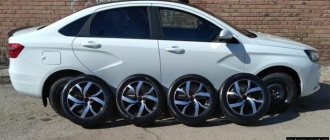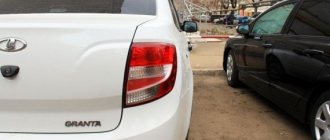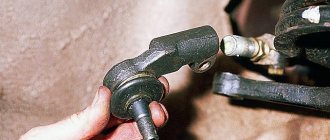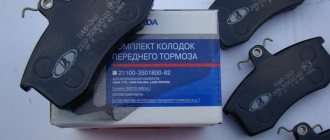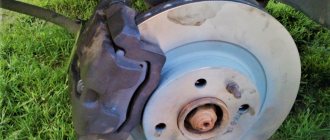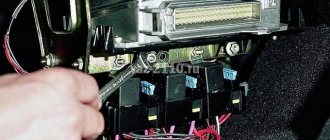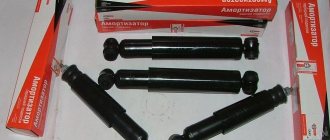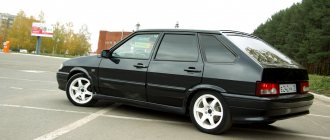175/65/14, Its advantages are known, it is more than completely indestructible, does not wear out, is not afraid of driving off the asphalt, if carefully and leisurely, then even on snow and ice. I ran forty thousand on mine. Cons: It's noisy on the highway and uncomfortable at high speed, in combination with the wobbly steering wheel.
I want to pick up a new one for Granta, with the transition to size 185/60/14. At the same time, I would like to preserve as much as possible some of the positive aspects of the Kama-217, perhaps sacrifice some advantages, and get a gain that will compensate for what I sacrificed.
I searched for a long time, went through dozens and dozens of tests. I don’t want to see any more of the idiocy that is published in “Behind the Wheel.” Well, a car magazine can’t be so corrupt. Either Amtel takes 1st place, beating Goodyear, or they constantly push Nokia to first place. Although according to the ADAC European tests, these Nokias are far from being among the leaders. Yes, and Nokia was involved in a fraud scandal. That is, please do not provide links to tests.
Only your detailed personal experience, preferably in comparison with others that you have personally ridden.
It is highly desirable to have personal experience with single-platform Kalina/Granta/Datsun cars. As you know, the same model in different sizes and on different vehicle platforms leads to different results.
I made up criteria for choosing new tires for myself, the arrangement of the points is not in order of importance, completely random, just as it came to mind and wrote it down. 1. Quieter than Kama-217 2. Not afraid of ruts. 3. Directional stability, to compensate for the wadded Grant steering wheel. 4. Do not wear out to zero in one or two seasons. 5. The sidewall must be strong. 6. Must be very widespread. 7. When leaving the road, don’t be completely helpless 8. Don’t be afraid of hydroplaning
.
These are the contradictory requirements for the bride to be smart, beautiful, and kind. :))) You need to choose two qualities out of three.
Driving conditions, most of the city. Kazan. With good main roads, and completely broken-down entrances to the courtyards in the morning and evening. From April, when the snow melts along with the asphalt, until October and early November, when the temperature is -1 +3, freezing, sometimes the first snow falls, melting into mush. With trips to the regions, with crawling in 1 gear for a distance of 20 km along broken “directions”. And rides on the hot asphalt in July along the highway.
I have considered and am considering the following models:
— Cordiant Road Runner
. the price is good, but the quality is unstable, depending on your luck with balancing, and they note sensitivity to rutting. There is rapid wear and tear. They say they produce it in two factories, in Yaroslavl and Tomsk, with a significant difference in quality. Price for 4 pcs. 7900 rub.
— Viatti Strada
- a strong sidewall, but Octavia owners, where it is installed from the factory, note noise and weak braking properties. Price for 4 pieces 8500 rub.
— Kama-224
, I considered it, but I think if I put it on, I won’t get any dramatic gains in any parameter, there will be the same eggs only in profile. Price for 4 pcs. 8100 rub.
— Pirelli Cinturato P1
— is installed on Datsuns/Vestas, and in my opinion on the Grants/Kalina2 luxury suites. The latest model is quite interesting. I felt the side panel in the store, it seemed thick, but not oak. According to the reviews I've read, it holds its course well and is indifferent to ruts. At the same time, there are extremes in reviews. Some people write about strength, others about bumps and breakdowns. Price for 4 pieces 10200 rub.
For those who comment, please do not suggest either Nokia or Nordman.
UPD. Please comment on these 4 models specifically. I’m not ready to consider others yet.
Granta is a relatively new front-wheel drive car, developed by VAZ on the basis of Kalina, and launched into production in 2011. Since that time, along with sedan-type models, the Lada Granta liftback began to be produced. The change of body did not affect the tire size, unlike the Sedan Sport modification.
We invite you to familiarize yourself with the parameters of the tires used on these cars, and also present a small selection of models for winter and summer.
Basic tire sizes
In principle, to find out what size tires can be installed on a Lada Granta, just look at the passport or at the plate on the inside of the car door.
Nevertheless, we present to your attention a list of parameters that the manufacturer declares using the example of modifications for the 2021 release:
| Modification | Basic size | Replacement options |
| 2190 Sedan/1.6 16V | R14 175/65 | R14 185/60R15 195/50 and 185/55 |
| 2190 Sedan/1.6 8V | R14 175/65 | No options |
| 2190 Sedan/1.6 16V Sport | R15 185/55 | R15 195/50R16 195/50 |
| 2191 Liftback/1.6 16V | R14 175/65 | R14 185/60R15 185/55 |
| 2191 Liftback/1.6 8V | R14 175/65 | R14 185/60R15 185/55 |
Old family (until 09.2018)
Sedan
:
| Equipment | Tire size with load capacity and speed indexes* | Disc size | |
| rim width (inches) | rim offset (ET), mm** | ||
| Standard | 175/70 R13 82T, N | 5J | 35 |
| Standard Norm Lux | 175/65 R14 82T, N 185/60 R14 82T, N 185/55 R15 82T, N | 5J, 51/2J, 6J | 35 |
| Sport | 185/55 R15 195/50 R16 | 5J, 51/2J, 6J | 35 |
R is not a radius, but a designation of the radius of the tire, and the number is the diameter of the rim in inches.
Liftback
:
| Equipment | Tire size with load capacity and speed indexes* | Disc size | |
| rim width (inches) | rim offset (ET), mm** | ||
| All modifications | 175/65 R14 82T, N 185/60 R14 82T, N 185/55 R15 82T, N, V | 5J, 51/2J, 6J | 35 |
- * Speed indices: T – up to 190 km/h, H – up to 210 km/h, V – up to 240 km/h. Load capacity indices: 82 – 475 kg.
- **Rim offset (ET) is the distance from the mating plane of the disc to the middle of the rim.
Wheel hub bolt pattern 4x98, DIA - 58.5.
Tire pressure
We found out which tires are suitable for the Lada Granta - now we’ll figure out the pressure. A lot depends on it during the operation of tires, the purchase of which is one of the sources of expense for any car owner. The pressure must be constantly monitored to ensure that the tires do not wear out too quickly.
Premature wear occurs when there is insufficient pressure, but over-pumping is also fraught with consequences.
- If the pressure is regularly lowered by 0.5 Atm less than the norm for 14 radius of 1.9 Atm in the front, and 2.0 Atm in the rear, the tires will last 4 times less - plus fuel consumption increases.
- With an even greater lack of pressure, the car may lose control and the braking distance increases.
- If you drive for a long time on half-flat tires and then inflate them, the tire may simply explode.
Therefore, you need to have a pressure gauge on hand, take measurements from time to time (especially in winter), and if you need to pump up the wheels. The front and rear pair of tires should have the same pressure.
Specific indicators depend on the wheel size. Take, for example, the 195/50 profile, which is one of the replacement options for the LADA Sedan Sport. If this is a radius of 15, then the optimal pressure is 2.3 Atm, and at radius 16 you need to pump 2.4 Atm.
Video - New LS wheels and Pirelli tires on Grant
I want to install 195/50 r15 for the summer, won’t it hurt anything?
Will it grate or not on the juice pendant?
by Adminrive · Published 09/12/2016
Does anyone know how to get rid of the milk smell in a car?
by Adminrive · Published 05/01/2017
White gruni paint color number 2013 issue
by Adminrive · Published 12/16/2013
- Comments 24
- Pingbacks 0
No, but it will be tough, so I advise 185/55/15, I will install one for myself.
no) you can plug in 16)
AAAAAAAAAAAAAAAAAA ... .. Take the book (operating manual) and read ....... OK Google to help, look for a bastard, leaf through the group of the group almost every day the same questions
Blah and why do you recommend 185/55 when 195/55 calmly enters, doesn’t rub anywhere, doesn’t wipe, doesn’t rub, doesn’t wash, doesn’t shit and rushes and everything is narmul
Moreover, you have Largus, what does Grant have to do with it.
Theme Options
Selection of tires by model
Knowing the size of the “shoes”, all that remains is to choose the style. Any car should have two sets of tires: winter and summer. Winter tires are installed without waiting for frost, but when the thermometer regularly drops below +5 degrees.
To save on the purchase of winter tires, some drivers make the mistaken decision to drive all-season tires. Therefore, we will make a small digression and explain why this should not be done.
When and what tires are needed for a car?
Let’s say right away that there are no tires that behave stably in any conditions. Why then is the tire called all-season? Because of the tread, which must have a deep relief and grooves through which water, dirt, and slush can easily pass.
All-season tires are tires that are comfortable to drive in the off-season, when the air temperature varies from +7 to -10 degrees. It is often marked M+S (mud/snow), which confuses many.
But in fact, an all-season tire is a summer tire and is not suitable for year-round driving, even in the southern regions of the country.
- All mud tires, and all winter tires, have an all-season tread. The only difference is in the rubber composition, which is designed for positive or negative wheel operation. On a winter tire, for better grip on icy roads, many thread-like sipes are made, which distinguishes it from all-season tires.
- Studless winter tires are popularly called Velcro. On such tires, the car feels great in icy conditions, but when the temperature outside is consistently positive (above +6-7 degrees), it must be changed to summer shoes.
- Winter tires are much softer, so if you try to drive them in the summer, they will wear out quickly. Studded tires are better suited for driving on snow, so when in winter you have to drive not on cleared asphalt, but on a country road, it is better to give preference to studded tires.
- All year round, all-season vehicles are driven mainly by trucks and buses, on which changing wheels is a labor-intensive process, and besides, there are usually more than four of them. True, in severe frosts and snowfalls they have a hard time riding on such tires.
And another important factor is for those who spend a lot of time driving. A tire for winter use is much softer than a summer one, but it is also noisy when driving, especially the studded one.
The summer one, and it is also an all-season one, in severe frosts “steals” and just rattles. And this is not to mention the fact that you will not so much ride on the ice as perform figure skating.
Non-standard tire size for LADA Granta
On some cars it is possible to install wheels in the size range R16 or R17. But car owners should be aware that often such a change can only harm the car and worsen its overall quality indicators.
When releasing the Lada Granta, wheels with a diameter of R16 are used only on the Sport version, while the tire size is 195/50. In addition to this size, setting this diameter is possible at 175/50, 185/40, 195/40 and below.
For other Lada 2190 models, specialists and car manufacturers do not recommend installing disks whose diameter exceeds R15. Since it has been proven that the higher this indicator, the greater the risk of disc deformation. Therefore, when choosing new wheels and tires, you should not experiment with new sizes. Tires with dimensions that do not differ from the factory assembly are best suited for the car.
Winter tires on Lada Granta
Now let's see which winter tires to choose for the Lada Granta:
Viatti Brina Nordico
A relatively new model, developed by the German Continental together with Italian engineers, and put into production at the facilities of the Nizhnekamsk tire plant.
An asymmetrical tread pattern, a combination of middle blocks with rows of studs along the edges and variable sidewall stiffness technology ensure safe movement and stability when cornering and when crossing uneven roads.
Toyo Observe Garit G3-Ice
Winter tires from the Japanese Toyo are deservedly considered one of the best. If previously only sellers and those who drove it knew about this, then a test carried out at the test site not so long ago left no doubt.
The best models for summer
Now let's present several worthy summer models:
Bridgestone Ecopia EP150
The tread of this Japanese tire is developed using a new technology (NANO-PROTECH), which makes it possible to reduce the coefficient of rotational resistance and, as a result, save fuel consumption. Plus, the EP150 turned out to be lighter in weight and almost silent.
Nitto NT860
Another Japanese tire produced in Malaysia. Very soft rubber, perfectly balanced and brakes, thanks to the deep tread, self-cleaning from dirt and snow. With all this, the best thing is the low price.
Kormoran Impulser B2
Serbian Kormoran was developed using Michelin technology. The tire is stable when driving at speed, does not “float” if it gets into a puddle, has excellent grip on the road and is controlled when cornering.
Matador MP 47 Hectorra
The new generation summer tire from Slovenia MP-47 Hectorra performs excellently on both dry and wet surfaces thanks to its asymmetrical pattern with four deep longitudinal grooves.
Tread elements are optimized to the maximum, which improves acceleration and braking efforts and reduces noise levels.
Which winter tires are best for a car, or what to put on it for the summer, is, of course, up to the owner to decide. It all depends on what climate zone you have to use the car and what roads you drive on. And our information is designed to understand the characteristics of certain models and the advisability of their use.
The question “which tires can be supplied on a grant” cannot be answered unambiguously. As with other cars, choosing tires and wheels is a priority for every driver, since the correct selection will ensure a comfortable and safe ride.
In order to choose the right size and find out which tires are best for the Lada Grant, you should look at many factors that directly influence the choice.
Sphere of influence of tires and wheels
To understand which tires are best suited for the Lada Granta, you first need to find out what the size of the tires and wheels of the car affects. Service station specialists note that when replacing tires, one should be guided by the fact that the difference in outer diameter is minimal.
The selection of tires affects the following features of vehicle operation:
- brake and traction characteristics;
- transmission;
- fuel consumption;
- atmospheric emissions.
Increasing the radius of the wheel, tire and rim has the following effects.
| Tire increase | Disc enlargement | Wheel enlargement | |
| Steering precision | + | + | + |
| Tire grip on wet roads | |||
| Tire grip on dry roads | + | ||
| General driving comfort | — | — | — |
| Fuel consumption | + | + | |
| Wear rate | + | ||
| General management indicators | + | + | + |
Legend: + - improvement, - - deterioration, 0 - no change.
Changing your tire size will definitely lead to changes in your vehicle's handling accuracy. As the volume of the tire becomes larger, the scale of the space in contact with the road surface increases. This provides ample opportunities for maneuverability.
What does the size of tires and wheels affect?
| Increasing disc diameter | Increasing rim width | Increasing tire width | |
| Car style | will improve | will improve | will improve |
| Road holding | will improve | will improve | will improve |
| Steering precision | will improve | will improve | will improve |
| Tire grip | Will not change | Will not change | will improve, but only on dry roads |
| Resistance to hydroplaning | Will not change | Will not change | will get worse |
| Comfort on rough roads | will get worse | Will not change | will improve |
| Road noise | Will not change | Will not change | will intensify |
| Gasoline consumption | Will not change | will increase | will increase |
| Tire wear | Will not change | Will not change | will increase |
It is worth noting that it is better to choose winter tires for the Lada Grant as narrow as possible. Thus, the pressure of the car on the road surface will be greater, and therefore the grip on the road will improve. Also, do not forget that wide tires are more sensitive to the ruts on the road, and low-profile tires will transfer even the smallest bumps to your butt.
The smaller the unsprung masses
(this includes a lot of tires and wheels), the better the car will hold the road and accelerate faster. For example, if you put wheels on a car that are 2 kg lighter each, then acceleration to 100 km/h will be reduced by 0.2 seconds.
Attention! Installing larger wheels may lead to problems with ABS and ESC calibration (the systems may not work correctly).
Let us remind you that for safety and to increase the service life of your tires, you should maintain the recommended pressure in the Lada Granta tires.
Where can I buy
: in our online store (category Discs for Grants).
Keywords: Lada Granta wheels | Lada Granta tires | Lada Granta Sport
+32
Share on social networks:
Found an error? Select it and press Ctrl+Enter..
Factory specifications of tires and wheels for LadaGranta
According to the factory specifications, the original tires supplied from the factory have a radius of R14 and R13. R14 is a fairly classic option for small cars. Both wheels and tires with these dimensional characteristics are inexpensive and are quite easy to find on the market. The situation is similar with the R13. Therefore, when analyzing which discs are suitable for the nagrant, you should keep this point in mind.
Size characteristics of tires and wheels, which are also suitable for LadaGranta Currently, all AvtoVAZ models with front-wheel drive are equipped with R15 size wheels. And although the original Lada Granta R15 tires with this wheel model have dimensional characteristics of 185/55, they will also fit well with tires 175/70, 185/60 and even 195/55.
What other tires and wheels are suitable for the Grant?
A survey was conducted among VKontakte users, asking them to choose alloy wheels for Granta. 42% of participants recommend installing R15 wheels on the Grant. 27% chose R14. Third place (17% of voters) believe that 16 wheels on Grant will look best. The left tire compatibility table is built for 175/70 R13, and the right one is for 185/55 R15:
Green indicates the minimum deviation of the wheel diameter (up to 3 mm); Orange indicates a diameter deviation from 3 to 6 mm.
Based on reviews from owners, we have compiled a list of compatibility of Lada Granta tires and wheels:
- R14 wheels on Granta can be installed with the following tire parameters: 175/60 R14, 175/55 R14, 175/50 R14, 175/45 R14, 175/40 R14, 185/55 R14, 185/50 R14, 185/45 R14 , 185/40 R14, 195/50 R14, 195/45 R14, 195/40 R14, 205/55 R14, 205/50 R14, 205/45 R14, 205/40 R14 and 205/32 R14.
- R15 wheels on the Grant are installed with the following parameters: 175/50 R15, 175/45 R15, 175/40 R15, 185/50 R15, 185/45 R15, 185/40 R15, 195/50 R15, 195/45 R15, 195/ 40 R15, 205/50 R15, 205/45 R15, 205/40 R15 and 205/32 R15.
- R16 wheels on the Grant are equipped with tires: 175/50 R16, 175/45 R16, 175/40 R16, 185/45 R16, 185/40 R16, 195/45 R16, 195/40 R16 and 205/32 R16.
- R17 wheels for the Grant (the same number voted for R13 wheels); it is recommended to install them with tires: 185/40 R17, 195/40 R17 and 205/32 R17.
Don't forget about the rim width:
When installing tires or wheels that differ in parameters
from those recommended by the factory, you can:
- be refused warranty repair of the chassis;
- be stopped by a traffic police inspector, who has the right to draw up a report on the car’s non-compliance with the requirements of the Technical Regulations;
- fail to pass technical inspection.
Factory tire pressure parameters LadaGranta
The pressure in the grant tires of the basic factory configuration, namely R13 and R14 at partial load looks like this: R13 (175/70) - 0.19/0.19 (1.9/1.9) R14 (175/65) - 0 .20/0.20 (2.0/2.0) Data are presented in the ratio “kg/cm2”. The pressure in Grant Sport tires is approximately at the same level, adjusted for the dimensional characteristics of the wheel, namely R16.
Correctly checking tire pressure. Recommendations
Constant monitoring of tire pressure levels ensures safe travel and prevents tire wear. If the pressure is at a low level (below 1.9 atmospheres), then the side parts of the tread, due to the uneven distribution of air when driving, will wear out much more. When tires are overinflated (above a value of 2.0), the middle part of the tread will suffer, which is also fraught with consequences.
List of negative consequences from uneven distribution of tire pressure:
- the scale of contact with the road is expanding;
- rapid and uneven tread wear;
- decreased vehicle controllability;
- potential danger of creating an emergency situation on the road.
To correctly measure tire pressure, you will need a pressure gauge. Measurements should be taken some time after the trip, so that the air in the tires has time to cool down after intense heating during driving. The optimal value (for R13 – 1.9, for R14 – 2.0) is indicated as a number that can be found on the gas tank or car door. It is important that when using the pressure gauge, air does not escape from the wheel.
The resulting value must be compared with the optimal one and pumped up to the desired value. For wheels that are parallel and on the same axis, the pressure level should be identical.
What is the tire pressure
Tire pressure is a relative value, but for tires of different sizes it should be almost the same. The pressure indicator does not mean the amount of air, but the ratio of air in the tire to its total volume.
According to the factory parameters, the pressure in R13 tires should be 1.9 atmospheres, while for R14 and R15 tires the pressure must be maintained at two atmospheres.
At the same time, do not forget about the regular load on the car. If the load is the average load capacity of a vehicle of this model, then the tire pressure must be maintained at the above level. In cases where most of the time the car owner loads the vehicle to the maximum, the tire pressure should be increased by 0.2 atmospheres.
Pressure tends to influence two of the most important indicators of a vehicle.
- Safety. You should not be lenient about the tire pressures recommended by the manufacturer in the vehicle's technical specifications. At high speeds, reduced pressure increases braking distance and reduces agility and controllability.
- Gasoline consumption. With a reduced level of tire pressure, the engine has to work more intensively, which leads to increased fuel consumption. In addition, the wear resistance of the tread is reduced.
Is it possible to install wheels of size R16 205/55 on the Lada Granta
Wheels with a radius of R16 and dimensions of 205/55 are not suitable for both the regular LadaGranta configuration and the Sport model. Due to their too large diameter, they will fit too tightly, which when driving will lead to rapid wear of the treads and reduced maneuverability of the vehicle. Owners of Lada Granta recommend installing 195/50 or 205/45 with a radius of R16.
Winter tires for Lada Granta
The selection of winter tires for the Lada Granta should be based on the characteristics of the terrain on which you will have to drive. If the roads are not cleared enough, and the winter threatens frequent thaws followed by frosts, then in this case you should use studded tires.
Tires for winter use must have soft contact with the road surface, which will provide a reliable degree of traction even on packed snow, and the tread base must be rigid for precise steering. Goodyear, Pirelli and Dinlop Winter companies have the necessary dimensional characteristics for the Lada Granta, namely in the range from R13 to R16.
Winter tires will also require running-in to ensure they fit firmly in their seats. For a good break-in, you will need to drive about 500 kilometers. When running in, you should try to avoid sudden braking and slipping. To improve traction, it is also recommended to choose tires with a narrow profile.
A short checklist - How to buy tires for the Lada Granta correctly
1. You should look for the right tires, keeping in mind the factory dimensional specifications. The size of the selected tires must match these data. 2. Pay attention to the tread pattern. Driving comfort largely depends on it.
3. Pay attention to the width parameters. The acceleration and braking of a car is affected by the width of the spot converging with the road surface. 4. Particular attention should be paid to the bore diameter. Tires that are excessively high or wide can damage the suspension, while tires that are too narrow will increase the load on the bearings. 5. It is important to consider the maximum speed index and load capacity index. 6. Treadwear, Traction, Temperature and MaxPressure data provide information on the tire's factory wear life, braking performance, temperature resistance and pressure limit for the tire respectively.
